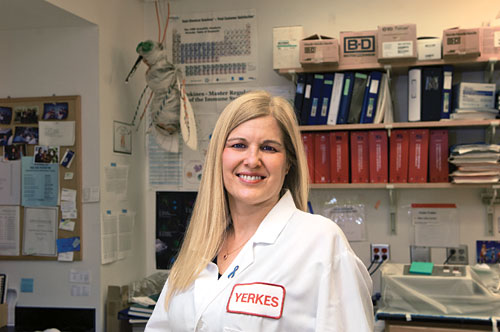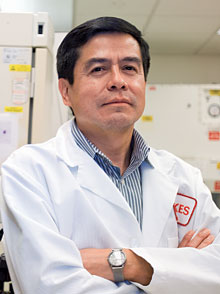Spring 2010: Dynamic Forces

net worker: Mary Galinski leads the Center for Malaria Research with a broad-based, interdisciplinary approach.
Kay Hinton
Mosquito-Borne Killer
Emory Vaccine Center’s malaria research program takes on an ancient, deadly parasite

Courtesy Gonzalo Vazquez-Prokopec
What is that thing?
Gonzalo Vazquez-Prokopec and Uriel Kitron, of the Department of Environmental Studies, have developed a battery-powered mosquito aspirator that improves upon those currently available for mosquito collection and is much easier to build. Understanding the habits and habitats of mosquitoes can go a long way toward developing tools and strategies for malaria prevention.
By Mary J. Loftus
King Tutankhamun, the young Egyptian ruler whose tomb contained legendary treasures, was a frail boy whose death came from complications from a broken leg and, researchers now believe, severe malaria.
Several years of DNA testing detected genes specific to the malaria parasite in several mummies, including Tut’s, a research team led by Egyptian archeologist Zahi Hawass reported in the February issue of the Journal of the American Medical Association (JAMA).
“Although there is no a clear evidence that malaria was the cause of King Tut’s death, it is exciting to have genetic evidence of malaria infection from a three-thousand-year-old royal mummy,” says Assistant Professor Alberto Moreno, codirector of the Emory Vaccine Center’s malaria vaccine core projects. “To make a malaria vaccine, it is critical for us to understand the interaction between the parasite and the host.”
A devastating, complex parasite, several different Plasmodium species infect three hundred million to five hundred million people a year and more than one million die—most of them children in sub-Saharan Africa. Endemic in about a hundred developing countries in Africa, Asia, and along the tropics, malaria thrives, despite the availability of antimalarial drugs. There is no malaria vaccine available yet, and new drugs are needed in the face of resistant parasites, which have been on the rise.
“At Emory, we take a broad-based approach—from understanding the various species and stages of disease development, to discovering parts of proteins that could be components of a vaccine and performing preclinical trials,” says Professor Mary Galinski. “We’re also seeking to identify disease processes unique to the parasite that can be disrupted with drugs.”
And that’s just the biological side of the battle: Galinski says researchers must also consider the social, cultural, and economic issues surrounding malaria.
A molecular parasitologist, Galinski joined Emory’s School of Medicine, Division of Infectious Diseases, in 1998, when the University was just building the Emory Vaccine Center (EVC). She established Emory’s malaria research program when the EVC opened in 1999. Her husband, John Barnwell, is chief of the malaria laboratory research and development unit for the Centers for Disease Control and Prevention. “We have built independent as well as highly collaborative research programs,” says Galinski. “It’s a great partnership.”

Malaria Fighter: Alberto Moreno is trying to discover as much about the parasite-host interaction as possible.
Bryan Meltz
Malaria in humans is caused by five species: Plasmodium falciparum, P. vivax, P. ovale, P. malariae, and P. knowlesi. The female Anopheles mosquito is the vector, or carrier, for malaria, which bites an individual infected with the disease and then passes the parasite on to someone else about two weeks later. Malaria parasites grow in the liver and then multiply in the blood, causing severe headaches, fever, chills, nausea, and sometimes, coma and death. To make matters worse, P. vivax and P. ovale malaria parasites can lie dormant in the liver for some time before restarting their multiplication cycle and illness in the blood.
Emory’s program is an international leader in researching P. vivax, which has received less attention than the more deadly P. falciparum but is proving to be dangerous in its own right. “We can’t eradicate malaria if we don’t think about vivax,” Galinski says. “Scientific leaders worldwide are coming to terms with this reality.” This includes colleagues across campus, foremost Professor Dennis Liotta, founder of Emory’s Institute for Drug Discovery, with whom they are researching new antimalarial drugs.
“When working with P. vivax and other malaria infections in monkeys, the parasite levels and health of the animals must be monitored daily,” says Yerkes Assistant Professor Esmeralda Meyer, a physician and member of the research team since 1999. “Between the parasite’s five-thousand-plus genes and many life stages, it’s quite different from working with a virus.”
In 2006, Galinski, Moreno, and Meyer established Emory’s International Center for Malaria Research, Education, and Development (ICMRED), with founding members from Colombia, China, Brazil, India, Vietnam, and a number of African countries. Collaborators also come from Australia, Papua New Guinea, Singapore, and several European countries. “We are interested in basic biological and genetic research, as well as developing and testing vaccines and drugs,” Galinski says. “We’re searching not just for the quick fix, but for long-term solutions, which include thinking about global health concerns, education, and development.”
To this end, in 2006 they helped launch the End Malaria–Blue Ribbon symbol, and engage students through an elective course on malaria and a seminar series called the Malaria Scholars Program, which seeks to train “malariologists.” Sam Cherribi, a senior lecturer in sociology, and Galinski have accompanied Emory students and fellows to Africa to learn firsthand about malaria and development issues.
“Fighting malaria helps you get creative,” Galinski says.
Funding for malaria research dwindled after the disease was eliminated in the United States and other wealthy countries by 1950. But research is now on an upswing with major funds from the Bill and Melinda Gates Foundation and others.
“There is revitalized interest in aiming for malaria eradication,” says Moreno, who is from Colombia and has worked on malaria vaccine development for twenty-five years. “Now, the strategy includes research for effective vaccines, new anti-malarial drugs, improved diagnostics, health infrastructure and political sustainability.”